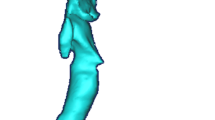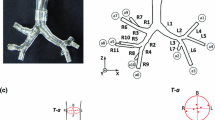Abstract
The main physiological function of coughing is to remove from the airways the mucus and foreign particles that enter the lungs with respirable air. However, in patients with endotracheal tubes, further surgery has to be performed to improve cough effectiveness. Thus, it is necessary to analyze how this process is carried out in healthy tracheas to suggest ways to improve its efficacy in operated patients. A finite element model of a human trachea is developed and used to analyze the deformability of the tracheal walls under coughing. The geometry of the trachea is obtained from CT of a 70-year-old male patient. A fluid structure interaction approach is used to analyze the deformation of the wall when the fluid (in this case, air) flows inside the trachea. A structured hexahedral-based grid for the tracheal walls and an unstructured tetrahedral-based mesh with coincident nodes for the fluid are used to perform the simulations with the finite element-based commercial software code (ADINA R&D Inc.). Tracheal wall is modeled as an anisotropic fiber reinforced hyperelastic solid material in which the different orientation of the fibers is introduced. The implantation of an endotracheal prosthesis is simulated. Boundary conditions for breathing and coughing are applied at the inlet and at the outlet surfaces of the fluid mesh. The collapsibility of a human trachea under breathing and coughing is shown in terms of flow patterns and wall stresses. The ability of the model to reproduce the normal breathing and coughing is proved by comparing the deformed shape of the trachea with experimental results. Moreover the implantation of an endotracheal prosthesis would be related with a decrease of coughing efficiency, as clinically seen.







Similar content being viewed by others
References
Balashazy, I., T. Heistracher, and W. Hoffmann. Air flow and particle deposition patterns in bronchial airway bifurcations: the effect of different CFD models and bifurcation geometries. J. Aerosol Med. 9:287–301, 1996.
Bathe, K. J., and H. Zhang. Finite element developments for general fluid flows with structural interactions, Int. J. Numer. Methods Eng. 60:213–232, 2004.
Bathe, K. J., H. Zhang, and S. Ji. Finite element analysis of fluid flows fully coupled with structural interactions. Comput. Struct., 72:1–16, 1999
Calay, R. K., J. Kurujareon, and A. E. Holdo. Numerical simulation of respiratory flow patterns within human lungs. Respir. Physiol. Neurobiol., 130:201–221, 2002.
Cebral J. R., and R. M. Summers. Tracheal and central bronchial aerodynamics using virtual bronchoscopy and computational fluid dynamics. IEEE Trans. Med. Imaging 23(8):1021–1033, 2004.
Costantino, M. L., P. Bagnoli, G. Dini, G. B. Fiore, M. Soncini, C. Corno, F. Acocella, and R. Colombi. A numericla and experimental study of compliance and collapsibility of preterm lamb trachea. J. Biomech., 37:1837–1847, 2004.
Cullen, A. B., P. H. Cooke, S. P. Driska, M. R. Wolfson, and T. H. Shaffer. The impact of mechanical ventilation on immature airway smooth muscle: functional, structural, histological and molecular correlates. Biol. Neonate, 90(1):17–27, 2006
Donea, J., S. Giuliani, and J. P. Halleux. An arbitrary Lagrangian–Eulerian finite element method for transient dynamic fluid-structure interaction. Comput. Methods Appl. Mech. Eng., 33:689–723, 1982.
Dumon, F. A dedicated tracheobronchial stent. Chest, 97:328–332, 1990.
Forster, C. H., W. A. Wall, and E. Ramm. Artificial added mass instabilities in sequential staggered coupling of nonlinear structures and incompressible flows. Comput. Methods Appl. Mech. Eng., 196:1278–1293, 2007.
Hazel, A. L., and M. Heil. Three-dimensional airway reopening: the steady propagation of a semi-infinite bubble into a buckled elastic tube. J. Fluid Mech., 478:47–70, 2003.
Heil, M. Airway closure: liquid bridges in strongly buckled elastic tubes. J. Biomech. Eng. (ASME), 121:487–493, 1999.
Heil, M., and J. P. White. Airway closure: surface-tension-driven non-axisymmetric instabilities of liquid-lined elastic rings. J. Fluid Mech., 462:79–109, 2002.
Holzapfel, G. A. Nonlinear Solid Mechanics. Wiley, New York, 2000
Kim, C. S., and A. J. Iglesias. Deposition of inhaled particles in bifurcating airway models: I. Inspiratory deposition. J. Aerosol Med., 2:1–14, 1989.
Kim, C. S., A. J. Iglesias, and L. Garcia. Deposition of inhaled particles in bifurcating airway models: II. Expiratory deposition. J. Aerosol Med., 2:15–27, 1989.
Liu, Y., R. M. C. So, and C. H. Zhang. Modeling the bifurcation flow in a human lung airway. J. Biomech., 35:465–473, 2002.
Lyubimov, G. A. The physiological function of the posterior tracheal wall. Doklady Biol. Sci., 380:421–423, 2001.
Ma, B., and K. R. Lutchen. An anatomically based hybrid computational model of the human lung and its application to low frequency oscillatory mechanics. Ann. Biomed. Eng., 34(11):1691–1704, 2006.
Maksym, G. N., L. Deng, N. J. Fairbank, C. A. Lall, and S. C. Connolly. Beneficial and harmful effects of oscillatory mechanical strain on airway smooth muscle. Can. J. Physiol. Pharmacol., 83(10):913–922, 2006
McClay, J. E. Laryngeal and tracheal stents. eMedicine , 2008
McCool, D. F. Global physiology and pathophysiology of cough. Chest, 129:48–53, 2006.
Miller, T. L., Y. Zhu, A. R. Altman, K. Dysart, and T. H. Shaffer. Sequential alteration of tracheal mechanical properties in the neonatal lamb: effect of mechanical ventilation. Pediatr. Pulmonol., 42:141–149, 2007
Nithiarasu, P., O. Hassan, K. Morgan, N. P. Weatherill, C. Fielder, H. Whittet, P. Ebden, and K. R. Lewis. Steady flow through a realistic human upper airway geometry. Int. J. Numer. Methods Fluid, 57:631–651, 2008.
Nowak, N., P. P. Kakade, and A. V. Annapragada. Computational fluid dynamics simulation of airflow and aerosol deposition in human lungs. Ann. Biomed. Eng., 31:374–390, 2003.
Oertel, H. Jr. Prandtl’s Essentials of Fluid Mechanics. New york: Springer, 2004.
Rains, J. K. Mechanical Properties of Tracheal Cartilage, MSc thesis. University of British Columbia, Vancouver, 1989.
Rains, J. K., J. L. Bert, C. R. Roberts, and P. D. Pare. Mechanical properties of human tracheal cartilage. J. Appl. Physiol., 72:219–225, 1992.
Roberts, C. R., J. K. Rains, P. D. Park, D. C. Walker, B. Wiggs, and J. L. Bert. Ultrastructure and tensile properties of Human tracheal cartilage. J. Biomech., 31:81–86, 1998.
Ross, B. B., R. Gramiak, and H. Rahn. Physical dynamics of the cough mechanics. J. Appl. Physiol., 8(3):264–268, 1985.
Sera, T., S. Satoh, H. Horinouchi, K. Kabayashi, and K. Tanishita. Respiratory flow in a realistic tracheostenosis model. J. Biomech. Eng., 125:461–471, 2003.
Spitzer, A. R., T. H. Shaffer, and W. W. Fox. Assisted ventilation: physiologic implications and complications. In: Fetal and Neonatal Physiology. Philadelphia: WB Saunders Company, 1992, pp. 812–894
Stephens, N. L., Cardinal, R., and B. Simmons. Mechanical properties of tracheal smooth muscle: effects of temperature. Am. J. Physiol. Cell Physiol., 233:C92–C98, 1977.
Wall, W. A., and T. Rabczuk. Fluid-structure interaction in lower airways of CT-based lung geometries. Int. J. Numer. Methods Fluid 57:653–675, 2008.
White, J. P., and M. Heil. Three-dimensional instabilities of liquid-lined elastic tubes: a lubrication theory model. Phys. Fluid, 17(3):031506–031506-17, 2005.
Yamada, H. Mechanical properties of respiratory and digestive organs and tissues. In: Strength of Biological Materials, edited by F. Gaynor Evans. Baltimore, MD: Williams and Wilkins, 1970.
Yang, X. L., Y. Liu, R. M. C. So, and J. M. Yang. The effect of inlet velocity profile on the bifurcation copd airway flow. Comput. Biol. Med., 36:181–194, 2006.
Zhang, Z., and C. Kleinstreuer. Transient airflow structures and particle transport in a sequentially branching lung airway model. Phys. Fluid, 14:862–880, 2002.
Zhang, Z., and R. Lessmann. Computer simulation of the flow field and particle deposition by diffusion in a 3-d human airway bifurcation. Aerosol Sci. Technol., 25:338–352, 1996.
Zhang, H., X. Zhang, S. Ji, Y. Guo, G. Ledezma, N. Elabbasi, and H. de Coughny. Recent development of fluid-structure interaction capabilities in the Adina system. Comput. Struct., 81:1071–1085, 2003.
Acknowledgments
The support of the Instituto de Salud Carlos III through the research project PI07/90023 and the CIBER initiative is highly appreciated. The authors gratefully acknowledge the technical support of Dr. Yiguang Yan (ADINA R&D Inc.).
Author information
Authors and Affiliations
Corresponding author
Additional information
Associate Editor John H. Linehan oversaw the review of this article.
Rights and permissions
About this article
Cite this article
Malvè, M., del Palomar, A.P., López-Villalobos, J.L. et al. FSI Analysis of the Coughing Mechanism in a Human Trachea. Ann Biomed Eng 38, 1556–1565 (2010). https://doi.org/10.1007/s10439-010-9951-3
Received:
Accepted:
Published:
Issue Date:
DOI: https://doi.org/10.1007/s10439-010-9951-3




